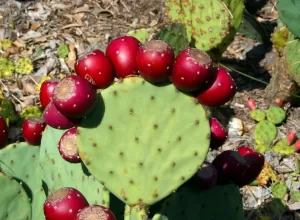Chenopodium nuttalliae
Huauzontle can be considered a superfood due to its rich nutritional profile, providing essential nutrients such as protein, fiber, calcium, iron, phosphorus and many vitamins, including A, C, E and B. Additionally, its abundant flavonoid content imparts potent antioxidant and anti-inflammatory properties, bolstering the immune system.
Phaseolus acutifolius
Phaseolus acutifolius, also known as the tepary bean, is a legume native to the southwestern United States and Mexico and has been grown there by the native peoples since pre-Columbian times. It is more drought-resistant than the common bean (Phaseolus vulgaris) and is grown in desert and semi-desert conditions from Arizona through Mexico to Costa Rica. The water requirements are low. The crop will grow in areas where annual rainfall is less than 400 mm (16 in).
Hippophae rhamnoides
Hippophae rhamnoides is a hardy, deciduous shrub that can grow between 2 and 4 m high (between 7 and 13 ft). It has a rough, brown or black bark and a thick, grayish-green crown. The leaves are alternate, narrow and lanceolate, with silvery-green upper faces. It is dioecious, meaning that the male and female flowers grow on different shrubs. The sex of seedlings can only be determined at the first flowering, which mostly occurs after three years. The male inflorescence is built up of four to six apetalous flowers, while the female inflorescence normally consists of only one apetalous flower...
Opuntia dillenii
Opuntia dillenii is a species of prickly pear native to the tropical and subtropical Americas. It is naturalized in many other parts of the world. It differs from O. stricta by having more spines per arose (usually more than 3).
The native range of this species is Mexico, S. Jamaica. It is a succulent shrub and grows primarily in the seasonally dry tropical biome. It is used as animal food and a medicine, has environmental uses and social uses and for food.









